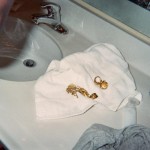Four Tet, Pink (Text)
Lost track of all the limited, self-released 12-inches Four Tet dropped on discerning dancefloors over the past year? It’s time to play catch up.
–
The Haxan Cloak, The Men Parted The Sea To Devour The Water (Southern)
The first entry in Southern’s long-running Latitudes series that we literally rushed out to buy–a limited CD/LP that serves as a segue between Bobby Krlic’s cult-cultivating debut and the Tri Angle LP that’s due out sometime next year. Haunting and heavy.
–
Holograms, Holograms (Captured Tracks)
A strange thing happened at Holograms’ Manhattan debut earlier this year: faced with a malfunctioning Korg, the restless Swedes were forced to brush their keyboardist aside and tackle their set as a power trio. As much as we love the bright synth lines and robotic rhythms on the band’s self-titled debut, their stripped-down sound emphasized the strengths of their post-punk leanings. Namely the vinegary yelps of singer/guitarist Anton Spetze–fans of the Cure’s early records will savor his Robert Smith-isms–and the post-adolescent pissiness of everything else. It’s like Iceage, only not as heated and hostile.
–
High on Fire, De Vermis Mysteriis (E1)
Considering how profoundly dazed and confused Matt Pike looks in 90-percent of High on Fire’s press photos–and every single one of Sleep’s–we’re not quite sure if it’s surprising or fitting that his latest flight of fantasy is a concept album centered around a Chinese alchemist, Quantum Leap-like time travel, and Jesus’ sacrificial twin. (What, you didn’t know he had one?) We’ll go with fitting, a classification that also applies to just how in the zone Pike and the rest of the band are throughout their sixth LP–a jilted journey that’s as expertly paced musically as it is thematically, right down to the smoky instrumental interlude that splits it in half.
–
Holy Other, Held (Tri Angle)
At this point, you probably know what a Tri Angle record sounds like. And contrary to popular belief, it’s not so much that godforsaken subgenre ‘witch-house’ as electronic music that’s laced with pitchy vocal snippets and spectral trails of house, hip-hop and R&B. Holy Other’s debut album takes that template into another territory however, making it a fine surrogate for the Burial album we’ve basically given up on hearing anytime soon. Not that Held is a consolation prize or anything; it’s got its own gloomy storyline and heart-sinking sound, as reflected in the empty sheets on its record sleeve.
–
HTRK/Tropic of Cancer, Part Time Punks Radio Sessions (Ghostly)
John Peel would approve.
–
John Maus, A Collection of Rarities and Previously Unreleased Material (Domino)
Nearly a decade of MySpace memories and previously unreleased pop moves is uncovered in this compilation, which reveals how fully formed John Maus’ gleaming synths and moonlit melodies were straight out of the gate. Whether he’s howling about “castles in the grave†or assuring us he’s not a cannibal at the top of his lungs, it takes some serious skills to sound this strange.
–
John Talabot, Æ’IN (Permanent Vacation)
As the curtain is raised on John Talabot’s debut album, unseen creatures of the night chirp, chatter and groan their way across a humid jungle and a house-y backdrop that about as deep as dance music gets. And with that, we’re off, plunged into the producer’s disorientating netherworld, a place where neo-classical clusters (“El Oesteâ€) coexist with dagger-chased divas (“Oro y Sangreâ€), rays of ultraviolet light (“Journeysâ€) and vocals that are pitched to a point of pure despair. Talabot’s richly woven samples don’t wallow in sadness, however; they simply feel human, as ready for the floor as they are for the living room.
–
Jon Porras, Black Mesa (Thrill Jockey)
Like Dylan Carlson’s latter-day manifestation of Earth, Jon Porras’ work with Barn Owlhas often felt like a painterly take on Neil Young’s wildly expressive Dead Man soundtrack. His second solo album furthers that approach with flare-chased guitar chords, improv-infused arrangements and tumble weed tropes that tell the story of an outlaw “who ventures deep into the desert only to discover the Black Mesa, a bridge between worlds:the desert counterpart to David Lynch’s Black Lodge, an entrance into cavernous mystery.†Judging by the way his journey ends–wandering through wordless cries and pillows of smoky feedback on “Beyond the Veil‖this mystery can’t be good, but hey, at least it amounts to a lonesome effort that’s on par with Porras’ other gig.
–
Killing Joke, MMXII (Spinefarm)
It’s never too late to dabble in post-punk’s dying breed.
–
KTL, V (Editions Mego)
Having missed the last couple installments of Stephen O’Malley and Peter Rehberg’s ongoing KTL project, we were immediately struck by just how fully realized V. Not that their other records were simply waves of wraith-like noise and desecrated drone tones; it’s just that they didn’t have Jóhann Jóhannsson–the Icelandic composer ratcheting up the tension in “Phill 2”–and the City of Prague Philharmonic involved. We can only hope that the inevitable VI is a complete neo-classical nervous breakdown.
–
Laurie Spiegel, The Expanding Universe (Unseen Worlds)
This expanded double-disc edition of Laurie Spiegel’s early electronic music LP makes a thorough case as to why artists like Emeralds and Oneohtrix Point Never are indebted to her delicately sequenced deep listening experiments.
–
Lee Gamble, Diversions 1994-1996 (PAN)
An EP sourced from mangled/manipulated jungle mixtapes–like the ghosts of DnB’s past–and the first of Gamble’s two essential 2012 releases. (He also dropped a tortured techno album called Dutch Tvashar Plumes.)
–
Lee Hazlewood, The LHI Years: Singles, Nudes & Backsides (1968-1971) (Light in the Attic, 2012)
That voice–whether it’s cutting through the smoke rings of “Some Velvet Morning†or the swooning strings of the lesser-known sides on The LHI Years–there’s nothing quite like it, is there? Of course, it doesn’t hurt that Lee Hazlewood’s also one hell of a songwriter, peppering his lucid/lurid tales of leather and lace, broken hearts and whiskey bottles, and morning after melancholia with psych-steeped melodies and urban cowboy undertones. A must if you’ve never walked these tumbleweed-dotted streets before.
–
Liars, WIXIW (Mute, 2012)
Like every Liars LP before it, WIXIW sounds like the score to an imaginary land only the band fully understands. In this case, drums drag like dead bodies and synths skitter, scamper and slide like selected ambient works that have been sitting on Aphex Twin’s hard drive since the mid ’90s. Sinister but subdued like the trio’s masterful Drum’s Not Dead album, WIXIW is a pressure cooker of the highest order, refusing to relinquish its choke hold on the listener while never raising its voice above a weightless whisper. Even the faster songs–see: the pulverized dance pop of “Brats†and the incredibly tense title track–feel like they’ve been sent from space, promising, but never delivering, any sort of release.
–
Loops of Your Heart, And Never Ending Lights (Magazine)
Axel Willner’s first Loops of Your Heart LP breaks the windswept spell of his work as the Field for something far spacier. It’s as if the producer’srecent move to Berlin has led him down the same road as the city’s leading kosmische cadets, from the metronomic melodies of Neu! to the continental drift chords of Cluster. With two tracks that pass the 10-minute mark and lots of partly cloudy passages that are light on beats and heavy on atmospherics, this one’s definitely fit for red-eye flights and armchairs–a living room listen that lives up to the flawless, trance-inducing efforts of the Field.
–
Lotus Plaza, Spooky Action At a Distance (Kranky)
Bradford Cox’s better half explores a similar brand of slightly experimental, perfectly constructed pop songs–ones that are swaddled in smoke and chased by clouds. Sounds like someone has a backup plan if that whole band thing doesn’t work out.
–
Mike Armine, Verse & Cleansing Undertones of Wake/Lift (Translation Loss)
One of the things that’s always separated Rosetta from other Neurisis bands is the attention to detail that frontman Mike Armine brings to the band’s sound design side. Striking a balance between the noise and ambient worlds like Ben Frost and Fennesz, Armine’s solo compositions hold up as stand alone pieces as well as anything on the Type or Touch catalogs. That’s why this double pack–a new album called Verse and the more tortured 2007 LP Cleansing Undertones of Wake/Lift–is able to hold our attention for nearly 90 minutes, passing through our speakers like a snow storm with passing moments of pure bliss.
–
Mohn, Mohn (Kompakt)
While they’d originally discussed working on a full Burger/Voigt record after reuniting for a rare live set and a few subsequent singles in 2007, Jörg Burger and Kompakt co-founder Wolfgang Voigt have carved out yet another corner in their daunting catalogs with Mohn. A natural extension of Burger’s Triola alias and Voigt’s seminal Gas project, it explores the astral plane realm of ambient music with–as is often the case with Kompakt releases–the perfect balance of experimental and pop elements. If Gas is the sonic manifestation of an afternoon spent exploring Germany’s Black Forest, then Mohn is like a remastered version of 2001: A Space Odyssey–menacing, mournful and meaningful.
–
Moss Icon, Complete Discography (Temporary Residence Ltd.)
Talk about a record that reminds us of the ’90s. Not the artists we witnessed firsthand–that’d be the Alternative Nation axis of post-Nirvana pessimists–more like the Dischord-borne emocore movement that we discovered later on. That’d be the point where the lunkheaded cleanup hitters of the hardcore scene gave way to a more sensitive, and dynamic, approach. And by sensitive, we don’t mean the Dashboard Confessional/Emo Diaries side of things. Bands like Moss Icon followed the lead of Embrace, Dag Nasty and Rites of Spring by setting free associative coffee shop ramblings against concentrated bursts of abject chaos and songs that could stretch on well past the five-minute mark. Hell, one track on here, “Lyburnum – Wit’s End (Liberation Fly),†is long enough to eclipse the entire side of an EP, showing Moss Icon in top form, an eccentric, wildly expressive take on what it means to be at your very wit’s end.
–
Monolake, Ghosts (Imbalance Computer Music)
The second part of a planned trilogy,Ghosts is a sufficiently creepy set of skittish techno tracks that blur the lines between cold-pressed synth compositions and painstakingly crafted field recordings from Robert Henke’s Berlin flat. It’s as if a pack of poltergeists were let loose in a room full of samplers and silverware, and told to have the time of their life so long as they keep everything to 140 beats per minute. That’s our interpretation of the situation, at least; here’s Henke’s.
––
Mount Eerie, Clear Moon (P.W. Elverum & Sun)
The less experimental–in Phil Elverum’s estimation, at least–of Mount Eerie’s two LPs this year, Clear Moon is still about as twisted as a ‘singer-songwriter’ record gets in 2012. Especially around the midway point, as majestic synth melodies collide with drunken horns and skittish drums on “Lone Bell†and the more progressive side of the black-metal spectrum is channeled amid the doom-y distortion, charred cymbals and chilling chorus lines of “Over Dark Water.†Other moments display signs of shimmering beauty despite being somewhat sinister, like the way droning keys wash over “The Place I Live†or the album’s towering title track seems to signal a death march off into the pale moonlight.
–
Murk, House Masters (Defected)
We stumbled upon this lengthy (seriously–it’s nearly two and a half hours) compilation while reading Other Music’s weekly newsletter, where Mikey IQ Jones wrote, “I think I may have literally cried out loud when I discovered that this had been released.†Having only a passing understand of house and never heard Murk before–despite their legendary status in the dance music underground, and remixes for Madonna, Debbie Harry, and RuPaul–our immediate response to these 20 deep cuts can be summed up by a sample in the second track: “I’m addicted to drums, and I’m a slave to the dark beat.â€
–
Nadja, Dagdrom (Broken Spine Productions)
If mumblecore was a type of music–as opposed to an overhyped film ‘movement’, circa 2005–it’d have quite the advocate in this corner, Aidan Baker and Leah Buckareff’s first drone-on disc in forever. (Or two years in Nadja time.) They’re joined by a live drummer here–none other than the Jesus Lizard’s Mac McNeilly, which lends a level of red-blooded noise rock to the proceedings. A welcome addition obviously.
–
Neurosis, Honor Found in Decay (Neurot)
The last time Neurosis released a new record, a little site named self-titled was still in its planning stages. So this record’s both a reminder of how long we’ve been around–nearly four years!–and what a momentous occasion new Neurosis records are. Whether you listen to metal LPs on a regular basis or only check extremmmmme artists out when they get Best New Music on Pitchfork–a designation this album most certainly deserves–this is essential listening. The soundtrack to the downfall of civilization, really, Mayan calendar be damned.





